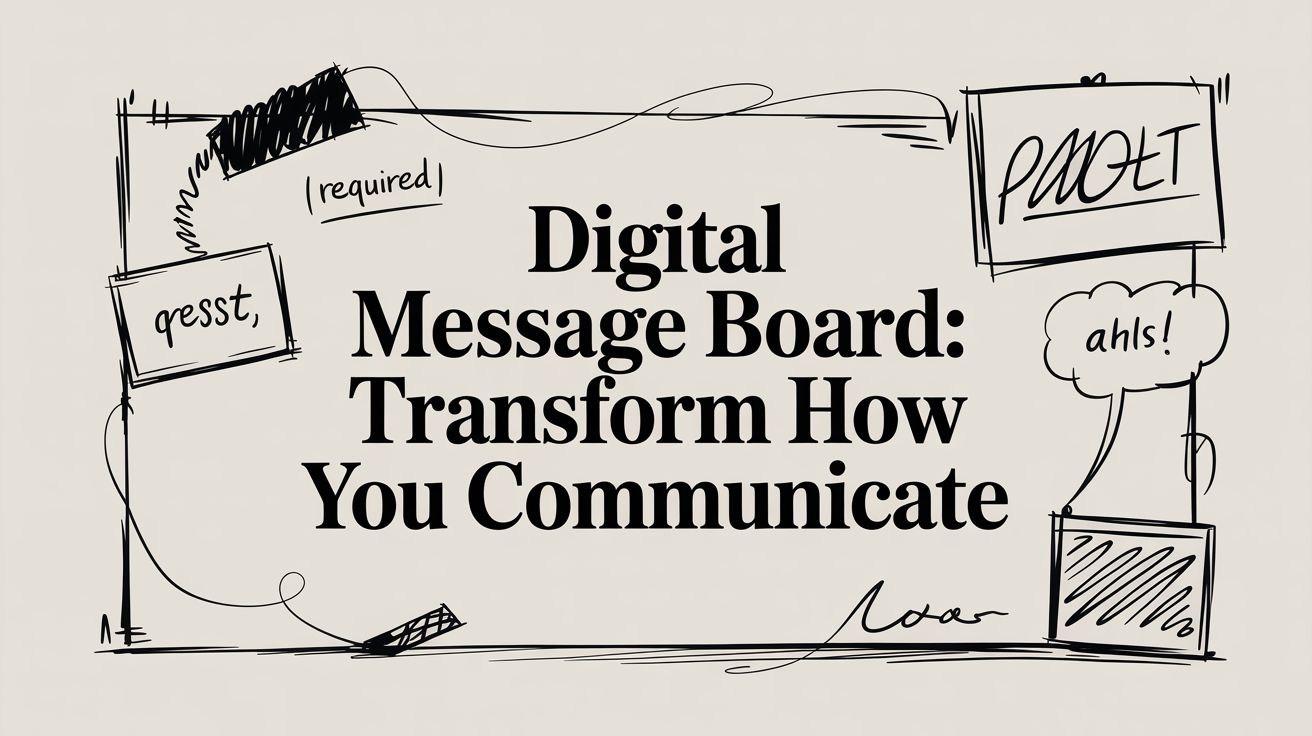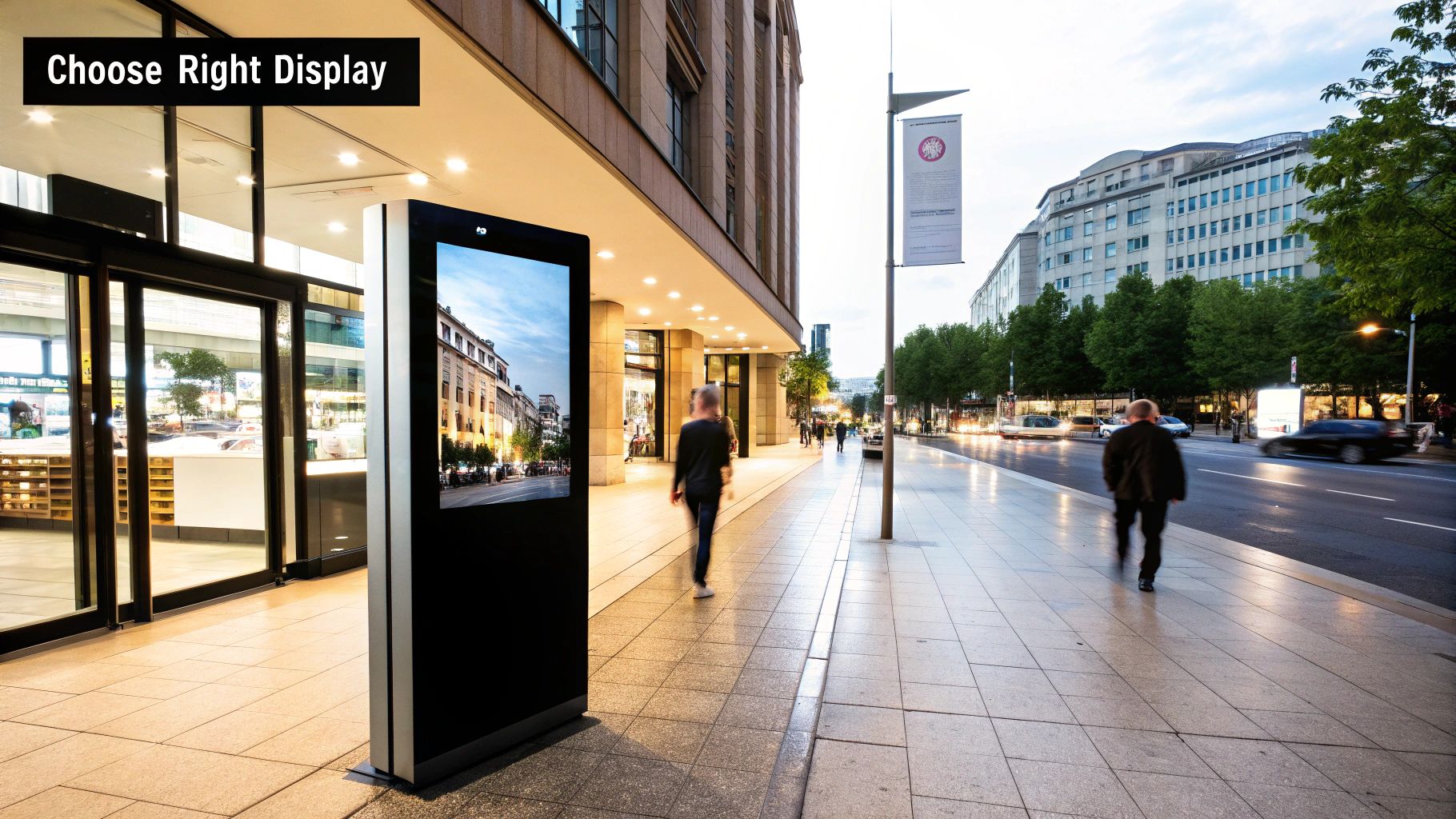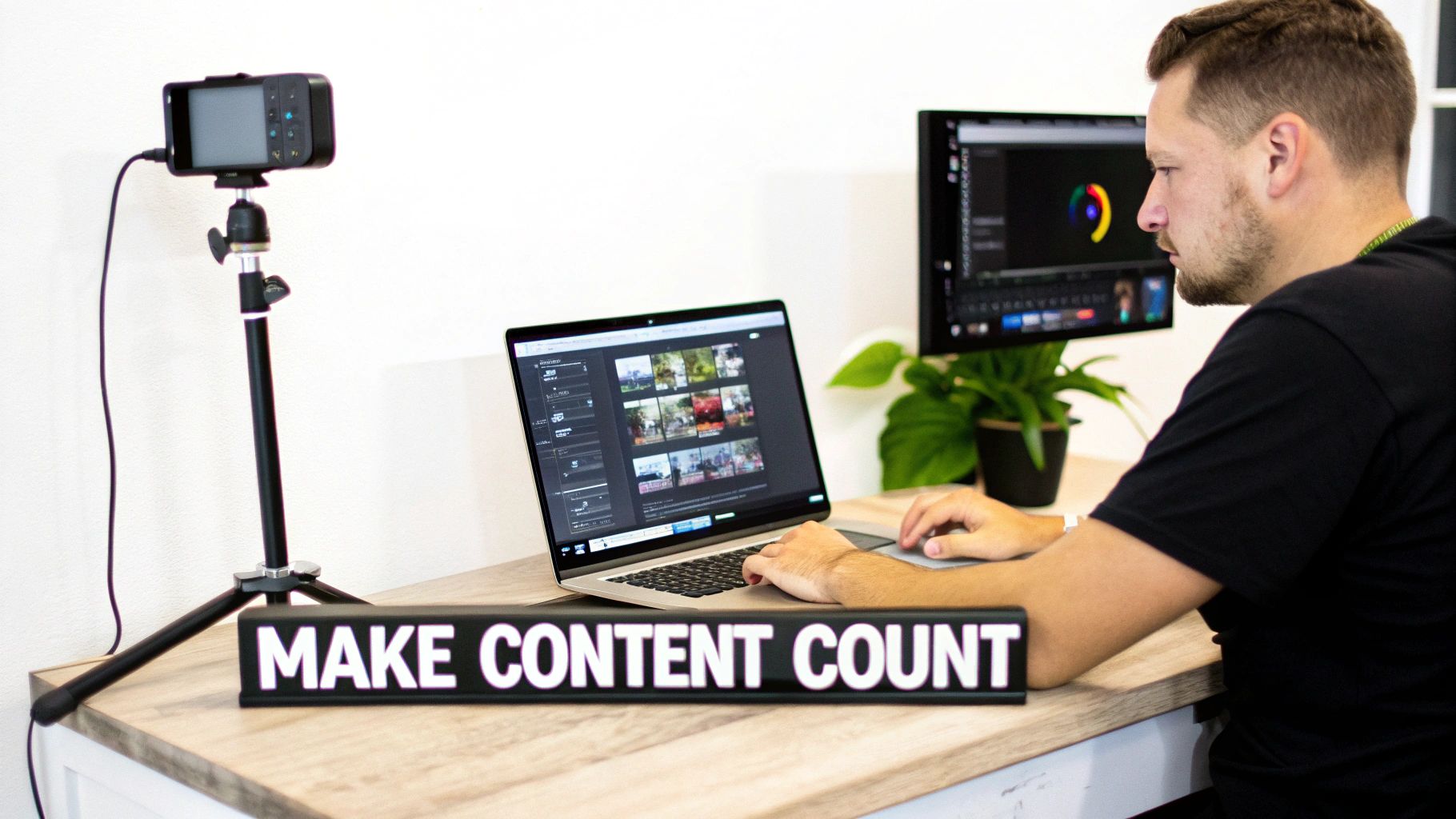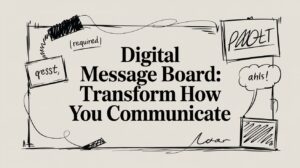
Choosing Scoreboards for Basketball A Complete Guide
A modern basketball scoreboard is so much more than a device for tracking numbers; it's the central nervous system of the entire game-day experience. It’s

A digital message board is more than just a screen; it's a living, breathing poster. Instead of static ink on paper, it uses brilliant screen technology to broadcast everything from public announcements and advertisements to emergency alerts—all in real time.

Let's cut through the jargon. A digital message board isn't just a fancy TV you hang outside. While a television is a passive device that just receives a signal, a digital sign is an active communication tool that you control, pushing specific content to a specific audience at a specific time.
This powerful system is made possible by three core components working in perfect harmony.
Think about announcing a flash sale at your store. A traditional poster is a one-and-done deal. You print it, hang it up, and that's the end of it. A digital sign, on the other hand, turns this into an instant, flexible conversation with your customers.
This magic happens thanks to three key elements:
A digital message board empowers you to replace static, forgettable posters with a dynamic, engaging dialogue. It’s the difference between a memo tacked to a wall and a live broadcast tailored to the moment.
The real power here lies in the ability to adapt. A printed sign is instantly obsolete. It can't react to a sudden downpour, an unexpected emergency, or a brilliant promotional idea you just had. It communicates one thing, and one thing only, until someone physically goes out and replaces it.
A digital display, however, is completely fluid. A school can use its sign to celebrate a football victory in the morning, issue a severe weather warning in the afternoon, and promote the upcoming school play in the evening—all without printing a single piece of paper.
This agility is what makes it such a vital tool for any organization that needs to communicate effectively and immediately. From local businesses and schools to entire city municipalities, this technology delivers timely, eye-catching information that truly grabs attention and drives people to act.

Picking out the perfect digital message board goes way beyond just screen size. The single most important factor is where the sign will live, a decision that completely changes the hardware you need. Right off the bat, this splits your options into two very different worlds: indoor and outdoor displays.
Think of an indoor sign like a high-quality art print framed for a gallery. It’s built for controlled environments—stable temperatures, zero direct sunlight, and up-close viewing. Its main job is to look slick and share crisp, clear information with people just a few feet away.
An outdoor sign, on the other hand, is a lighthouse beacon. It has to be a rugged, powerful workhorse built to conquer the elements while staying brilliantly visible. It battles blazing sunlight, shrugs off rain and snow, and handles extreme temperatures, all while projecting a message that’s sharp from hundreds of feet away.
The engineering that goes into these two types of displays couldn't be more different. An outdoor digital message board is packed with specialized components that would be total overkill indoors, while an indoor board would fail almost instantly if you put it outside.
To give you a clearer picture, here’s a quick rundown of what sets them apart.
| Feature | Indoor Digital Message Board | Outdoor Digital Message Board |
|---|---|---|
| Brightness (Nits) | 500-1,000 nits is plenty for indoor viewing. | Needs a minimum of 5,000+ nits to combat direct sunlight. |
| Weatherproofing (IP Rating) | No special protection needed. | Requires a high IP rating (like IP65) to seal out dust, rain, and snow. |
| Cooling System | Usually relies on passive cooling or simple ventilation. | Has robust active cooling systems with fans and heat sinks to handle heat. |
| Durability & Enclosure | Sleek, lightweight designs focused on aesthetics. | Heavy-duty, sealed metal enclosures built to withstand physical impact. |
| Viewing Distance | Designed for close-up viewing with a very fine pixel pitch. | Built for long-distance viewing with a larger pixel pitch. |
| Cost | Significantly lower due to less complex hardware. | Higher initial investment due to ruggedized, high-performance components. |
The takeaway is simple: you can't fake it. An outdoor board is built for endurance and power, while an indoor board is crafted for clarity and aesthetics in a protected space.
Just as crucial as where your sign will be is the technology that makes it shine. While older digital signs sometimes used LCD (Liquid Crystal Display)—the same tech in most TVs—the industry has overwhelmingly moved to LED (Light Emitting Diode) for nearly all professional jobs.
LCD screens work by shining a backlight through liquid crystals. It creates a decent image but struggles with brightness and longevity, especially outdoors. LEDs, in contrast, are the light sources themselves. Each pixel is just a tiny cluster of red, green, and blue diodes creating light directly.
This fundamental difference gives LED a massive edge.
This blend of durability, visibility, and efficiency is exactly why LED technology now runs the show for any serious digital signage project. Digging into the different LED signs for businesses can help you pinpoint the model with the right features for your specific goals.
https://www.youtube.com/embed/WoeHj-vTBi4
Understanding the hardware is one thing, but seeing how a digital message board transforms everyday business is where the magic really happens. Across dozens of industries, these dynamic displays are solving communication headaches, driving sales, and even improving safety in ways static signs never could.
They are, quite simply, powerful tools for delivering the right message to the right people at exactly the right time.
The explosive growth of this technology tells its own story. The global digital signage market has swelled to a value of around USD 28.8 billion. And it's not slowing down—projections show it growing at a rate of about 8.1% annually, expected to hit nearly USD 46 billion by 2030. This isn't just a trend; it's a fundamental shift driven by businesses of all sizes seeing real, tangible results.
When you pair this technology with other modern tools, the results get even better. For instance, integrating your on-screen promotions with digital loyalty solutions for business transformation can create a powerful, seamless experience that keeps customers coming back.
In the fast-paced world of retail and restaurants, you have to be nimble. A digital message board lets a store manager launch a flash sale for slow-moving inventory in minutes. A restaurant can update its menu on the fly to feature a daily special or 86 an item that just sold out.
These signs can run eye-catching video ads for new arrivals, showcase glowing customer testimonials, or simply reduce perceived wait times with entertaining content. It's all about grabbing attention and reacting instantly.
Schools and corporate offices are basically small cities, buzzing with information. A digital information board acts as a central town square, making sure everyone stays in the loop. Instead of relying on paper flyers that get tossed or emails that go unread, these organizations can broadcast critical messages where people can't miss them.
For a school, this means:
In the corporate world, these signs reinforce company culture, display key performance indicators (KPIs) to fire up the sales team, and offer a professional welcome to important visitors in the lobby. It’s about creating a more connected and informed community, minute by minute.
Think about an airport, train station, or bus terminal. These places are entirely dependent on clear, real-time information. A digital message board is the nerve center, displaying live arrival and departure times, gate changes, and delay notifications. This clarity is absolutely crucial for managing the flow of people and keeping travel stress to a minimum.
In public spaces, digital signs are the heartbeat of communication. They guide, inform, and alert thousands of people every day, turning potential chaos into organized, efficient movement.
Hospitals use them for the same reason—digital displays help with wayfinding in complex buildings, share important public health announcements, and manage patient queues in waiting rooms. On city streets, municipalities use them to communicate traffic jams, promote community festivals, and issue public safety warnings.
Our guide on digital outdoor signage dives deeper into how these rugged displays are built to serve communities 24/7. From boosting sales in a local shop to guiding travelers through a chaotic airport, the applications are as varied as they are valuable.
Alright, let's get into the nuts and bolts. Diving into the world of digital message boards for the first time can feel like you're trying to learn a new language. You'll hear terms like "pixel pitch," "nits," and "IP ratings" thrown around, and it's easy to feel overwhelmed.
Consider this section your personal translator. We're going to break down the specs that actually matter into simple, practical terms. Think of these details not as jargon, but as the DNA of your sign. Each one tells you exactly how your board will perform in the real world, and understanding them is the key to getting it right.
One of the first specs you'll run into is pixel pitch. It sounds technical, but the concept is surprisingly simple. It’s just the distance, measured in millimeters, from the center of one tiny LED light (a pixel) to the center of the one next to it.
The smaller the number, the closer the pixels are packed together.
Think of it like creating a mosaic. If you use big, clunky tiles spaced far apart, the picture looks blocky and undefined up close. But if you use tiny tiles packed tightly together, you can create a stunning, high-resolution masterpiece.
Pixel pitch works the exact same way for a digital message board. A smaller number means more pixels are crammed into the same space, giving you a sharper, crisper image that looks incredible even from just a few feet away.
This is all about your audience's viewing distance.
Getting this wrong is one of the most common and costly mistakes. A pitch that’s too large for your viewing distance will make your content look pixelated and amateurish, completely undermining your investment.
Next up is brightness, and in the world of LEDs, we measure it in nits. It might sound a bit quirky, but one nit is roughly the light produced by a single candle. That doesn't sound like much, but these numbers add up fast, and they are absolutely critical for your sign's visibility.
An indoor digital message board might only need around 500 nits to look brilliant inside an office. For comparison, the screen on your smartphone probably puts out 400 to 600 nits.
But an outdoor sign? It's in a constant battle with the sun.
To stay clear and vibrant on a bright, sunny day, an outdoor sign needs some serious power. We're talking a bare minimum of 5,000 nits, with high-performance displays often pushing 7,000 nits or more. Anything less, and your message will look faded, washed-out, and completely unreadable.
Finally, how are you going to update your sign? This is all handled by software, which typically comes in two flavors: cloud-based or on-premise.
Cloud-based software is the modern standard for good reason. It lets you control your digital message board from literally anywhere with an internet connection—your office desktop, your laptop at home, or even your phone while you're on the go. This flexibility is a game-changer, allowing for instant updates from anywhere in the world.
On-premise software is the old-school alternative. It's installed on a single computer that's physically connected to the sign. While it offers a direct connection that can feel more secure to some, it's incredibly rigid. To change the message, you have to be sitting at that specific computer.
For the vast majority of businesses today, the convenience and remote access of a cloud-based system is the clear winner. It lets you stay responsive and keep your content fresh without being chained to a desk.
Let’s be clear: buying a digital message board isn't like picking up a new TV at the big-box store. It’s a real investment in how your business or organization communicates, and getting it right means looking way beyond the initial price tag. You have to consider the total cost of ownership—hardware, software, installation, and the upkeep that keeps it running smoothly for years.
The first thing most people think about is size, and while that’s a big factor, the technical details are where the real cost drivers lie. Things like pixel pitch and brightness have a huge impact on the final price. A sign with a super-tight pixel pitch meant for up-close viewing is going to cost more than one designed to be seen from a highway. Likewise, a tough-as-nails, incredibly bright outdoor sign built to shrug off rain and snow will naturally have a higher price than a sleek indoor display.
This breaks down how the core specs influence both performance and what you'll end up paying.

As you can see, pitch, brightness, and resolution are all tangled together. Nailing the right balance is the secret to getting a fantastic result without blowing your budget.
Before you even think about calling vendors for quotes, you need a clear plan. Knowing exactly what you need not only makes the buying process smoother but also helps you compare your options apples-to-apples.
Start by getting answers to these four key questions:
Once you have these answers, you're ready to have a productive conversation with vendors and get quotes that actually make sense for your project. For a deeper look at the numbers, check out our guide on outdoor LED sign cost.
At the end of the day, a digital sign needs to earn its keep by delivering a solid return on investment (ROI). And we're not just talking about dollars and cents. ROI can also mean making your operations more efficient, building stronger brand loyalty, or even improving safety for your community.
A digital sign isn't an expense; it's a revenue-generating and communication-enhancing asset. By forecasting its impact, you can build a powerful business case that justifies the initial outlay.
This isn’t some niche trend; it’s a massive shift in how businesses communicate. The digital signage market in the U.S. alone is expected to jump from USD 9.07 billion in 2025 to a staggering USD 12.92 billion by 2030. This growth is being fueled by everything from increased ad spending to the simple fact that digital displays are becoming a standard part of modern buildings. It’s proof that this technology has serious long-term value.
So, how do you calculate your potential ROI? Think about it in these terms:
When you frame the purchase around these concrete benefits, the conversation shifts from "how much does it cost?" to "what will this investment do for us?" And that's a much more powerful way to think about it.

Let's be honest: even the most advanced digital message board is just an expensive, blank slate without killer content. The technology gets the screen on the wall, but it’s the visuals you put on it that make people stop, look, and actually remember your message.
Pulling this off is both an art and a science. The real trick is to design for a glance, not a long read. People are almost always on the move when they see your sign, so your message has to land in just three to five seconds. This means you have to worship at the altar of simplicity and clarity.
Designing for a bright, glowing screen is a whole different ballgame than designing for print. What looks fantastic on paper can easily dissolve into an unreadable mess on a digital display. The name of the game is maximum impact with zero clutter.
Here are the core principles you need to nail:
Your digital message board isn't a webpage; it’s a billboard. Its job is to deliver a quick, powerful punch of information, not a detailed story. Prioritize brevity and visual impact every single time.
A screen that shows the same static message day in and day out quickly becomes invisible—just another part of the scenery. The true power of a digital information board is its ability to change, so you have to lean into that. A varied playlist keeps your screen fresh and gives people a reason to keep looking.
To make sure your content grabs viewers right away, it's worth digging into some strategies for creating engaging video hooks.
Try rotating through a mix of these content types:
Finally, you need to think about when your messages are displayed. One of the best features of modern digital signage software is the ability to schedule content down to the minute. This lets you tailor your communication to perfectly match your audience's daily rhythm.
For example, a restaurant could run its breakfast specials from 7 AM to 11 AM, automatically switch to lunch deals, and then roll out its dinner features in the evening. A school could flash bus reminders at the end of the day and promote the big game at night. This kind of targeted scheduling makes your messages feel relevant to the moment, which makes them infinitely more effective.
Even after getting the big picture, it’s totally normal to have a few more questions rattling around. This last section is all about tackling the common queries we hear day in and day out, giving you the straight answers you need to move forward with confidence.
This is always the first question, and the honest answer is: "It depends." A small, simple sign for your lobby might only run a few thousand dollars. But a massive, high-definition screen meant to stop traffic on a busy street? That could easily get into the tens of thousands.
The final price tag really boils down to a few key things:
Forget the old days of needing an IT guru to update your sign. Modern digital message boards are built for real people to use. If you can handle a social media post or whip up a quick PowerPoint slide, you’ve already got all the skills you need.
Most signs today are run through simple, cloud-based software. This means your team—even the non-technical folks—can log in from any computer or phone, drag and drop a new graphic, type out a message, and schedule it to go live in seconds.
The whole point of modern sign software is to make content updates as quick and painless as sending an email. Your sign should always feel fresh and relevant, not like a technical chore.
Think of a professional-grade outdoor LED sign as a long-term investment, not a disposable piece of tech. These things are built like tanks. The high-quality LEDs inside are typically rated for an operational life of around 100,000 hours.
What does that actually mean? It translates to over 11 years of non-stop, 24/7 operation. With a bit of proper care and typical daily use, most businesses find their digital message board is a reliable workhorse for well over a decade, delivering a fantastic return on that initial investment.
Ready to transform how you communicate? The team at Smart LED Inc. can help you design the perfect digital message board for your budget and goals. Explore our solutions today.

A modern basketball scoreboard is so much more than a device for tracking numbers; it's the central nervous system of the entire game-day experience. It’s

Sure, the digital world gets all the hype, but when it comes to forging real connections and landing qualified leads, nothing beats a killer trade

A digital message board is more than just a screen; it's a living, breathing poster. Instead of static ink on paper, it uses brilliant screen
"*" indicates required fields